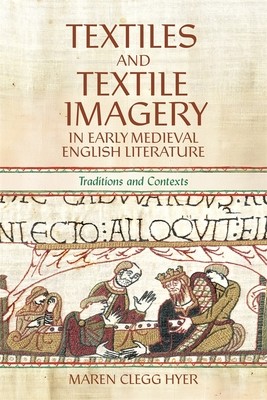
- We will send in 10–14 business days.
- Author: Maren Clegg Hyer
- Publisher: Boydell & Brewer
- ISBN-10: 1843847442
- ISBN-13: 9781843847441
- Format: 15.6 x 23.4 x 1.6 cm, kieti viršeliai
- Language: English
- SAVE -10% with code: EXTRA
Textiles and Textile Imagery in Early Medieval English Literature (e-book) (used book) | bookbook.eu
Reviews
Description
Identifies and analyses a wide range of textile metaphors and imagery from peace-weaving in Beowulf to word-crafting in Elene.
Textile metaphors, or metaphors involving the process and product of cloth-making, occur widely in literary traditions around the world. The same phenomenon holds true among the peoples of early medieval England. As close observers of a long and culturally significant textile tradition, pre-Conquest English writers drew upon their close familiarity with spinning and weaving to create a wide range of metaphorical textile images in both Old English and Anglo-Latin literature. This book examines early medieval English textile imagery in close detail, situating it within its cultural and material contexts, and addressing the ways in which lived experience informed these metaphors, whether inherited, invented, or both. It explores imagery linked to themes of creation, peace, death, magic and fate in a variety of texts, including Beowulf and Elene, prognostics, penitentials, hagiographic and homiletic texts, medical collections and the Exeter Book riddles. Overall, it demonstrates how an understanding of this important body of textile metaphors alters and shapes the ways in which we read the literature of this period.EXTRA 10 % discount with code: EXTRA
The promotion ends in 23d.17:13:33
The discount code is valid when purchasing from 10 €. Discounts do not stack.
- Author: Maren Clegg Hyer
- Publisher: Boydell & Brewer
- ISBN-10: 1843847442
- ISBN-13: 9781843847441
- Format: 15.6 x 23.4 x 1.6 cm, kieti viršeliai
- Language: English English
Identifies and analyses a wide range of textile metaphors and imagery from peace-weaving in Beowulf to word-crafting in Elene.
Textile metaphors, or metaphors involving the process and product of cloth-making, occur widely in literary traditions around the world. The same phenomenon holds true among the peoples of early medieval England. As close observers of a long and culturally significant textile tradition, pre-Conquest English writers drew upon their close familiarity with spinning and weaving to create a wide range of metaphorical textile images in both Old English and Anglo-Latin literature. This book examines early medieval English textile imagery in close detail, situating it within its cultural and material contexts, and addressing the ways in which lived experience informed these metaphors, whether inherited, invented, or both. It explores imagery linked to themes of creation, peace, death, magic and fate in a variety of texts, including Beowulf and Elene, prognostics, penitentials, hagiographic and homiletic texts, medical collections and the Exeter Book riddles. Overall, it demonstrates how an understanding of this important body of textile metaphors alters and shapes the ways in which we read the literature of this period.

Reviews